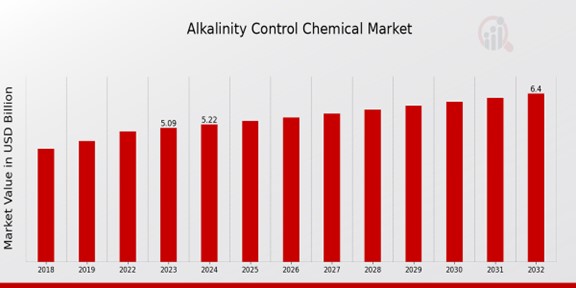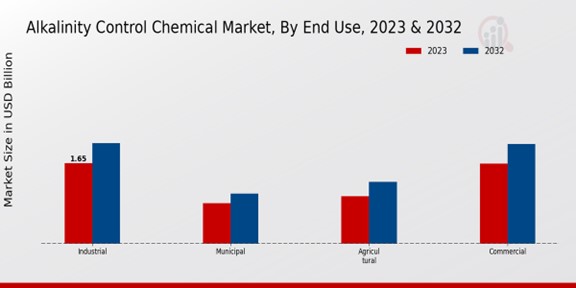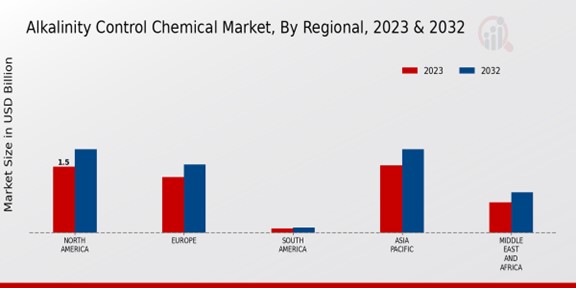Global Alkalinity Control Chemical Market Overview
Alkalinity Control Chemical Market Size was estimated at 5.35(USD Billion) in 2024. The Alkalinity Control Chemical Industry is expected to grow from 5.49(USD Billion) in 2025 to 6.9(USD Billion) by 2034. The Alkalinity Control Chemical Market CAGR (growth rate) is expected to be around 2.60% during the forecast period (2025 - 2034).
Key Alkalinity Control Chemical Market Trends Highlighted
Key market drivers for alkalinity control chemicals include the growing demand for water treatment, increasing industrialization, and stringent environmental regulations. The growing awareness of the importance of water quality and the need for effective wastewater treatment are driving the demand for alkalinity control chemicals. Rising industrialization and urbanization are leading to increased wastewater generation, which is further fueling the demand for these chemicals. Stricter environmental regulations are also mandating the use of alkalinity control chemicals to minimize the environmental impact of wastewater discharge.
Opportunities in the alkalinity control chemical market lie in the development of innovative and sustainable technologies. The increasing demand for water conservation and reuse is creating opportunities for the development of more efficient and environmentally friendly alkalinity control chemicals. Additionally, the growing focus on reducing chemical consumption and minimizing waste generation is opening up opportunities for the development of alternative and biodegradable alkalinity control chemicals.
Recent trends in the alkalinity control chemical market include the adoption of advanced technologies such as electrochemical and ion exchange processes. These technologies offer improved performance and efficiency in alkalinity control while reducing chemical consumption and environmental impact. The trend towards automation and digitalization is also gaining traction, enabling real-time monitoring and control of alkalinity levels in water treatment systems. Furthermore, the increasing adoption of green chemistry principles is driving the development and use of sustainable alkalinity control chemicals, such as those derived from plant-based materials or produced through eco-friendly processes.

Source: Primary Research, Secondary Research, MRFR Database and Analyst Review
Alkalinity Control Chemical Market Drivers
Rising Demand for Water and Wastewater Treatment
industrialization and the increasing population have become a common source of enormous amounts of water supply and sewage production. This has put pressure on the existing water sources and facilities, calling for the use of modern water and wastewater treatment technologies. For efficient operations of these systems, alkalinity control chemicals are needed to adjust the pH of water and waste water.The rising demand for efficient water and waste water treatment technologies is anticipated to drive the Alkalinity Control Chemical Market Industry.
Stringent Environmental Regulations
Governments worldwide are implementing stricter environmental regulations to protect water resources and ecosystems. These regulations mandate the reduction of pollutants in wastewater discharges, including alkalinity. Alkalinity control chemicals are essential for complying with these regulations by neutralizing acids and adjusting pH levels. The increasing focus on environmental stewardship is expected to boost the demand for alkalinity control chemicals.
Technological Advancements
Ongoing advancements in water treatment technologies are creating new opportunities for alkalinity control chemicals. The development of more efficient and cost-effective methods for pH adjustment is expected to drive the adoption of alkalinity control chemicals in various applications. Research and development efforts are focused on developing innovative formulations and delivery systems to meet the evolving needs of the Alkalinity Control Chemical Market Industry.
Alkalinity Control Chemical Market Segment Insights
Alkalinity Control Chemical Market End Use Insights
The Alkalinity Control Chemical Market is segmented into end-use industries such as industrial, municipal, agricultural, and commercial. Among these, the industrial segment held the largest market share in 2023, accounting for over 40% of the revenue. This is primarily due to the high demand for alkalinity control chemicals in industries such as power generation, oil and gas, and chemical manufacturing. The municipal segment is expected to witness significant growth in the coming years, owing to increasing urbanization and the need for efficient wastewater treatment.The agricultural segment is also projected to grow steadily, driven by the rising demand for alkalinity control chemicals in soil conditioning and crop protection. The commercial segment includes applications in hospitality, food and beverage, and healthcare and is expected to contribute a moderate share of the overall market revenue.

Source: Primary Research, Secondary Research, MRFR Database and Analyst Review
Alkalinity Control Chemical Market Application Insights
The application segment plays a crucial role in shaping the Alkalinity Control Chemical Market, with each application presenting unique market dynamics. Water Treatment, a major application, is projected to dominate the market, accounting for over 40% of the Alkalinity Control Chemical Market revenue in 2023. The growing demand for clean and safe water for various industrial, municipal, and domestic purposes drives the segment's growth. Wastewater Treatment is another significant application, with an estimated market share of around 25% in 2023 and a steady growth trajectory.Stringent environmental regulations and increasing awareness about wastewater management contribute to the segment's expansion. Cooling Systems represent a substantial application segment, particularly in industries such as power generation, manufacturing, and HVAC. The demand for alkalinity control chemicals in cooling systems is fueled by the need to prevent corrosion, scale formation, and fouling, ensuring efficient operation. Boilers, used for steam generation in various industries, also contribute to the Alkalinity Control Chemical Market.Alkalinity control is crucial in boilers to prevent scale buildup and corrosion, thus ensuring optimal performance and extending equipment life. Swimming Pools, a growing application segment, utilize alkalinity control chemicals to maintain proper pH levels, prevent corrosion, and ensure bather comfort and safety. The increasing popularity of residential and commercial swimming pools drives the segment's growth.
Alkalinity Control Chemical Market Chemistry Insights
The Chemistry segment is a crucial aspect of the Alkalinity Control Chemical Market. Key players in this segment include notable industry participants. In 2023, the Alkalinity Control Chemical Market for Chemistry was valued at around USD 2.35 billion and is projected to reach approximately USD 2.86 billion by 2032, exhibiting a CAGR of roughly 2.2% during the forecast period. Among the various types of alkalinity control chemicals, Sodium Bicarbonate, Potassium Bicarbonate, Calcium Carbonate, Sodium Carbonate, and Potassium Carbonate hold significant market shares.Sodium Bicarbonate, widely used in the food and beverage industry as a leavening agent and in water treatment applications, accounted for a substantial portion of the market revenue in 2023. The demand for potassium bicarbonate, which is employed in pharmaceutical formulations and glass manufacturing, is also anticipated to drive market growth. Calcium Carbonate, primarily used in papermaking and construction materials, is another key contributor to the segment's revenue. Sodium Carbonate, utilized in the production of detergents and glass, and Potassium Carbonate, employed in fertilizers and ceramics, are expected to witness steady market growth in the coming years.
Alkalinity Control Chemical Market Form Insights
The Alkalinity Control Chemical Market is segmented by form into solid, liquid, and gas. Among these, the solid segment held the largest market share in 2023, accounting for over 55% of the market. The solid form of alkalinity control chemicals is preferred due to its ease of handling, storage, and transportation. It is also less corrosive and has a longer shelf life compared to liquid and gas forms. The liquid segment is expected to witness the fastest growth during the forecast period due to the increasing demand for liquid chemicals in various industrial applications.Alkalinity Control Chemical Market revenue from the solid segment is projected to reach USD 3.2 billion by 2032, growing at a CAGR of 2.6%. The growing demand for solid alkalinity control chemicals in the water treatment industry is driving the growth of this segment. The Alkalinity Control Chemical Market segmentation by form provides valuable Alkalinity Control Chemical Market data and Alkalinity Control Chemical Market Statistics that can help businesses make informed decisions regarding product development, marketing strategies, and target markets.
Alkalinity Control Chemical Market Grade Insights
The Alkalinity Control Chemical Market is segmented by Grade into Food Grade, Technical Grade, and Pharmaceutical Grade. The Food Grade segment is expected to account for the largest share of the market in 2024, owing to its wide application in the food and beverage industry. The Technical Grade segment is expected to grow at a faster rate during the forecast period due to the increasing demand from the chemical and manufacturing industries. The Pharmaceutical Grade segment is expected to hold a significant share of the market due to its use in the production of pharmaceuticals and personal care products.
Alkalinity Control Chemical Market Regional Insights
The regional segmentation of the Alkalinity Control Chemical Market offers valuable insights into the market's geographical distribution and growth prospects. North America holds a significant share of the market, driven by stringent environmental regulations and a growing focus on water treatment infrastructure. Europe follows closely, with a mature market and a strong presence of chemical manufacturers. The APAC region is expected to witness substantial growth over the forecast period, owing to rapid industrialization and increasing water scarcity.South America and MEA represent emerging markets with untapped potential, offering opportunities for market expansion. These regional insights are crucial for businesses seeking to identify potential growth areas, tailor their strategies, and optimize their market presence.

Source: Primary Research, Secondary Research, MRFR Database and Analyst Review
Alkalinity Control Chemical Market Key Players and Competitive Insights
Major players in the Alkalinity Control Chemical Market are increasingly focusing on developing innovative products and expanding their presence. The Alkalinity Control Chemical Market industry is characterized by intense competition, with leading Alkalinity Control Chemical Market players adopting various strategies to gain a competitive edge. These strategies include product innovation, strategic partnerships, acquisitions, and geographic expansion. The competitive landscape is expected to remain highly competitive in the coming years, with new entrants and established players constantly vying for market share.A leading company in the Alkalinity Control Chemical Market is BASF. The company offers a wide range of alkalinity control chemicals, including soda ash, sodium bicarbonate, and caustic soda. BASF has a strong presence, with manufacturing facilities in Europe, Asia, and the Americas. The company is committed to sustainability and has implemented various initiatives to reduce its environmental impact. BASF is also actively involved in research and development and is continuously developing new and innovative alkalinity control chemicals.A competitor company in the Alkalinity Control Chemical Market is Solvay. The company offers a similar range of alkalinity control chemicals to BASF and has a strong presence. Solvay is committed to innovation and has a dedicated research and development team. The company is also focused on sustainability and has implemented various initiatives to reduce its environmental impact. Solvay is a strong competitor to BASF and is expected to continue to challenge the company's market share in the coming years.
Key Companies in the Alkalinity Control Chemical Market Include
- BASF
- Veoliawater Technologies
- Kemira
- SUEZ Water Technologies Solutions
- Solvay
- Buckman
- Suez
- Dow
- Ecolab
- Afton Chemical
- Activon
- NALCONewparaKurita Water Industries
Alkalinity Control Chemical Market Industry Developments
The Alkalinity Control Chemical market is projected to grow at a CAGR of 2.57% during the forecast period of 2024-2032, reaching a total market size of USD 6.4 billion by 2032. This growth is attributed to the increasing demand for water treatment chemicals, particularly in developing regions, where water scarcity and pollution are major concerns. Additionally, the rising adoption of advanced water treatment technologies, such as membrane filtration and reverse osmosis, is driving the demand for alkalinity control chemicals. The market is expected to witness significant growth in the Asia-Pacific region due to the increasing population and urbanization, as well as growing investments in water infrastructure.
Alkalinity Control Chemical Market Segmentation Insights
Alkalinity Control Chemical Market End Use Outlook
- Industrial
- Municipal
- Agricultural
- Commercial
Alkalinity Control Chemical Market Application Outlook
- Water Treatment
- Wastewater Treatment
- Cooling Systems
- Boilers
- Swimming Pools
Alkalinity Control Chemical Market Chemistry Outlook
- Sodium Bicarbonate
- Potassium Bicarbonate
- Calcium Carbonate
- Sodium Carbonate
- Potassium Carbonate
Alkalinity Control Chemical Market Form Outlook
Alkalinity Control Chemical Market Grade Outlook
- Food Grade
- Technical Grade
- Pharmaceutical Grade
Alkalinity Control Chemical Market Regional Outlook
- North America
- Europe
- South America
- Asia Pacific
- Middle East and Africa
| Report Attribute/Metric |
Details |
| Market Size 2024 |
5.35(USD Billion) |
| Market Size 2025 |
5.49(USD Billion) |
| Market Size 2034 |
6.9(USD Billion) |
| Compound Annual Growth Rate (CAGR) |
2.60% (2025 - 2034) |
| Report Coverage |
Revenue Forecast, Competitive Landscape, Growth Factors, and Trends |
| Base Year |
2024 |
| Market Forecast Period |
2025 - 2034 |
| Historical Data |
2020 - 2024 |
| Market Forecast Units |
USD Billion |
| Key Companies Profiled |
BASF, Veoliawater Technologies, Kemira, SUEZ Water Technologies Solutions, Solvayn, Buckman, Suez, Dow, Ecolab, Afton Chemical, Activon, NALCONewparaKurita Water Industries |
| Segments Covered |
End Use, Application, Chemistry, Form, Grade, Regional |
| Key Market Opportunities |
Increasing industrial water treatment, growing demand for alkalinity control in power plants, rising wastewater treatment expanding paper and pulp industry, and surging adoption in cooling towers |
| Key Market Dynamics |
Increased industrial water usage Growing demand from power plants Stringent environmental regulations |
| Countries Covered |
North America, Europe, APAC, South America, MEA |
Frequently Asked Questions (FAQ) :
The Alkalinity Control Chemical Market is expected to reach a value of USD 5.49 billion in 2025.
The Alkalinity Control Chemical Market is projected to grow at a CAGR of 2.60% from 2025 to 2034.
North America is expected to hold the largest market share in the Alkalinity Control Chemical Market in 2023.
Alkalinity Control Chemicals are primarily used in water treatment, wastewater treatment, and industrial processes such as papermaking, textiles, and food processing.
Major competitors in the Alkalinity Control Chemical Market include Solvay, Kemira, BASF, Dow, and Nalco Water.
Growing demand for water treatment, increasing industrialization, and rising environmental concerns are key factors driving the growth of the Alkalinity Control Chemical Market.
Stringent environmental regulations, fluctuating raw material prices, and competition from alternative technologies are some of the challenges faced by the Alkalinity Control Chemical Market.
The Alkalinity Control Chemical Market is expected to reach a value of USD 6.9 billion by 2034.
Water treatment is expected to hold the largest market share in the Alkalinity Control Chemical Market in 2023.
The Alkalinity Control Chemical Market in the Asia-Pacific region is expected to grow at a CAGR of 3.2% from 2024 to 2032.

















